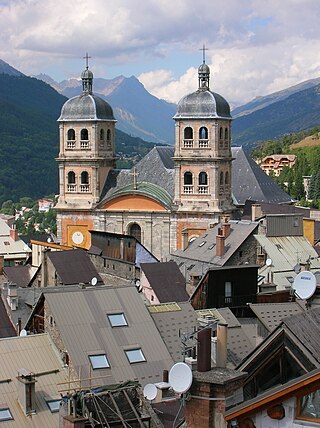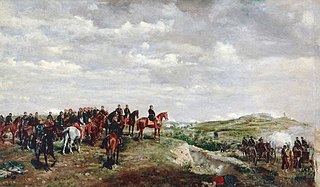
The War of the Austrian Succession was a European conflict fought between 1740 and 1748, primarily in Central Europe, the Austrian Netherlands, Italy, the Atlantic Ocean and Mediterranean Sea. Related conflicts include King George's War in North America, the War of Jenkins' Ear, the First Carnatic War, and the First and Second Silesian Wars.

The Cottian Alps are a mountain range in the southwestern part of the Alps. They form the border between France and Italy (Piedmont). The Fréjus Road Tunnel and Fréjus Rail Tunnel between Modane and Susa are important transportation arteries between France and Italy (Turin).

Briançon is the sole subprefecture of the Hautes-Alpes department in the Provence-Alpes-Côte d'Azur region in Southeastern France. It is the highest city in France at an altitude of 1,326 metres, based on the national definition as a community containing more than 2,000 inhabitants. Its most recent population estimate is 11,084 for the commune.

The Battle of Toulouse took place on April 10, 1814, just four days after Napoleon's surrender of the French Empire to the Sixth Coalition, marking one of the final conflicts of the Napoleonic Wars. Having pushed the demoralised and disintegrating French Imperial armies out of Spain in a difficult campaign the previous autumn, the Allied British-Portuguese and Spanish army under the Duke of Wellington pursued the war into southern France in the spring of 1814.

Villefranche-sur-Mer is a resort town in the Alpes-Maritimes department in the Provence-Alpes-Côte d'Azur region on the French Riviera and is located south-west of the Principality of Monaco, which is just west of the French-Italian border.

The Second Italian War of Independence, also called the Sardinian War, the Austro-Sardinian War, the Franco-Austrian War, or the Italian War of 1859, was fought by the Second French Empire and the Kingdom of Sardinia against the Austrian Empire in 1859 and played a crucial part in the process of Italian Unification.

The siege of Turin took place from June to September 1706, during the War of the Spanish Succession. A French army led by Louis de la Feuillade besieged the Savoyard capital of Turin, whose relief by Prince Eugene of Savoy has been called the most brilliant campaign of the war in Italy. The siege is also famous for the death of Piedmontese hero Pietro Micca.
The Second Battle of Casteldelfino was a military engagement in July 1744 during the War of the Austrian Succession between France and the Kingdom of Sardinia.
The Battle of Madonna dell'Olmo or Battle of Cuneo was fought on the outskirts of Cuneo on 30 September 1744, in the War of the Austrian Succession. The battle ended in a victory for the armies of Spain and France over the Kingdom of Sardinia but it did not advance the victors' campaign.

The siege of Toulon took place between 29 July to 21 August 1707 during the War of the Spanish Succession, when a combined Savoyard-Imperial army supported by a British naval force, attacked the French base at Toulon.

The siege of Cuneo was fought on 28 June 1691 during Nine Years' War in Piedmont-Savoy, modern-day northern Italy. The siege was part of French King Louis XIV’s campaign against Victor Amadeus, the Duke of Savoy, who had sided with the Grand Alliance the previous year. The siege was an attempt to gain a foothold on the Piedmont Plain, thus ensuring Marshal Catinat's army could winter east of the Alps. Yet due to the incompetence of the two French commanders – and a timely arrival of Imperial reinforcements – the siege proved a disaster, resulting in the loss of between 700 and 800 men. Although French forces had taken Nice in the west, and Montmélian in the north, Catinat's small, ill-equipped army was forced onto the defensive. Louis XIV subsequently offered Amadeus generous peace terms but the Duke, who had by now received substantial Imperial reinforcements from the Empire, considered himself strong enough to continue hostilities.

The Battle of Assietta was a significant engagement of the War of the Austrian Succession and pitted a numerically superior French force of 25,000 men under the command of Louis Fouquet, Chevalier de Belle-Isle against a Sardinian army of 15,000 men led by Giovanni Bricherasio. The French were soundly defeated and their commander, Belle-Isle, killed during the course of the battle. The siege was part of the Italian campaign of the War of the Austrian Succession, in which Habsburgs and Bourbons contested for domination over Northern Italy and the various Italian states. The Kingdom of Sardinia joined the war on the side of the Pragmatic Allies in 1742 and rallied itself to Maria Theresa's cause. There were also concerns about growing French influence in its territories. The war in Italy had already been going on for seven years, and the Sardinian army had already suffered several defeats in the field, leading to them opting for a more defensive approach. The French led several expeditions in Italy during the war, combining their forces with the Spanish Bourbons to accomplish their political aims.

The Italian invasion of France, also called the Battle of the Alps, was the first major Italian engagement of World War II and the last major engagement of the Battle of France.
The Old Fort of Nassau, also known as Fort Nassau, was a fort in Nassau, Bahamas, first built in 1697. The fort lasted for nearly two hundred years with a rich legacy of history until it was finally demolished in 1897. It was located on the north side of Marlborough Street, on the site of the current British Colonial Hilton Nassau. Remnants of the old walls can be seen on the hotel grounds. For many years it was the only fort in Nassau.

The Second Battle of Saorgio was fought from 24 to 28 April 1794 between a French First Republic army commanded by Pierre Jadart Dumerbion and the armies of the Kingdom of Sardinia-Piedmont and the Habsburg monarchy led by Joseph Nikolaus De Vins. It was part of a successful French offensive designed to capture strategic positions in the Maritime Alps and Ligurian Alps, and on the Mediterranean coast. Tactical control of the battle was exercised by André Masséna for the French and Michelangelo Alessandro Colli-Marchi for the Coalition. Saorge is located in France, about 70 kilometres (43 mi) northeast of Nice. At the time of the battle, the town was named Saorgio and belonged to Piedmont.
The Battle of Genola or Battle of Fossano was a meeting engagement between a Habsburg Austrian army commanded by Michael von Melas and a Republican French army under Jean Étienne Championnet. Melas directed his troops with more skill and his army drove the French off the field, inflicting heavy losses. The War of the Second Coalition action represented the last major French effort in Italy during 1799. The municipality of Genola is located in the region of Piedmont in northwest Italy a distance of 27 kilometres (17 mi) north of Cuneo and 58 kilometres (36 mi) south of Turin.

The First Battle of Saorgio saw a French army commanded by Gaspard Jean-Baptiste Brunet attack the armies of the Sardinia-Piedmont and Austria led by Joseph Nikolaus De Vins. The local Sardinian commander in the Maritime Alps was Charles-François Thaon, Count of Saint-André. Though the French were initially successful in this War of the First Coalition action, their main assaults against the strong defensive positions on the Massif de l'Authion and the Col de Raus failed with serious losses. Saorge is now located in France about 70 kilometres (43 mi) northeast of Nice, but in 1793 Saorgio belonged to Piedmont. In April 1794 the French seized the positions from the Austro-Sardinians in the Second Battle of Saorgio.

The French expedition to Sardinia was a short military campaign fought in 1793 in the Mediterranean Sea in the first year of the War of the First Coalition, during the French Revolutionary Wars. The operation was the first offensive by the new French Republic in the Mediterranean during the conflict, and was directed at the island of Sardinia, part of the Kingdom of Sardinia. Sardinia was neutral at the time, but immediately joined the anti-French coalition. The operation was a failure, with attacks directed at Cagliari in the south and La Maddalena in the north both ending in defeat.

The Second Battle of the Alps was a military campaign fought between combined German and Italian Social Republic forces, and the re-established French Republic led by Charles de Gaulle and other Allied forces.

The 52nd Infantry Regiment "Alpi" is an inactive unit of the Italian Army last based in Portogruaro. The regiment carries the traditions of Giuseppe Garibaldi's Hunters of the Alps, which were formed in spring 1859 for the Second Italian War of Independence. In September 1859, the five Cacciatori delle Alpi regiments were merged into two regiments and integrated into the Royal Sardinian Army's infantry arm. In 1866, the 52nd Infantry Regiment "Alpi" participated in the Third Italian War of Independence. In 1911-12 the regiment fought in the Italo-Turkish War. During World War I, the regiment fought on the Italian front and then on the Western Front. Before the outbreak of World War II, the regiment was assigned to the 22nd Infantry Division "Cacciatori delle Alpi", with which it fought in the Greco-Italian War and was then sent to occupied Yugoslavia as occupation force. After the announcement of the Armistice of Cassibile on 8 September 1943 the division and its regiments were disbanded by invading German forces.















